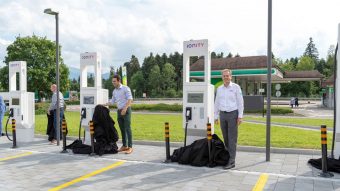The world lost more than one football pitch of forest every second in 2017, according to new data from a global satellite survey, adding up to an area equivalent to the whole of Italy over the year.
The scale of tree destruction, much of it done illegally, poses a grave threat to tackling both climate change and the massive global decline in wildlife. The loss in 2017 recorded by Global Forest Watch was 29.4m hectares, the second highest recorded since the monitoring began in 2001.
Global tree cover losses have doubled since 2003, while deforestation in crucial tropical rainforest has doubled since 2008. A falling trend in Brazil has been reversed amid political instability and forest destruction has soared in Colombia.

In other key nations, the Democratic Republic of Congo’s vast forests suffered record losses. However, in Indonesia, deforestation dropped 60% in 2017, helped by fewer forest fires and government action.
Forest losses are a huge contributor to the carbon emissions driving global warming, about the same as total emissions from the US, which is the world’s second biggest polluter. Deforestation destroys wildlife habitat and is a key reason for populations of wildlife having plunged by half in the last 40 years, starting a sixth mass extinction.
“The main reason tropical forests are disappearing is not a mystery – vast areas continue to be cleared for soy, beef, palm oil, timber, and other globally traded commodities,” said Frances Seymour at the World Resources Institute, which produces Global Forest Watch with its partners. “Much of this clearing is illegal and linked to corruption.”
Just 2% of the funding for climate action goes towards forest and land protection, Seymour said, despite the protection of forests having the potential to provide a third of the global emissions cuts needed by 2030. “This is truly an urgent issue that should be getting more attention,” she said. “We are trying to put out a house fire with a teaspoon.”
The new data is based on 30m resolution satellite data and records all forest loss, including that from forest fires. Human destruction causes virtually all deforestation in the tropics, a vast haven of both carbon and wildlife. Fires are dominant at higher latitudes, causing roughly two-thirds of losses in Russia and Canada, and may be becoming more common due to climate change.
New forests are being grown, in China and India for example, but the precise extent to which these offset the destruction of existing ones is not yet known, although it is clear that deforestation significantly exceeds afforestation. It is estimated that only about 15% of the forests likely to have existed before human civilisation remain intact today: a quarter have been razed and the rest fragmented or degraded.
Brazil, with its vast Amazon territory, is vital in fighting deforestation and for a decade from 2005 a government crackdown lead to falling deforestation. But tree felling is now rising fast again, as political strife distracts the authorities. “What we are seeing today is the backlash,” said Carlos Nobre at the University of São Paulo, Brazil.
More than a quarter of Brazil’s tree losses in 2017 were due to fires deliberately set to clear land. “Global warming makes much hotter temperatures, making forests more vulnerable to human-set fires and natural-caused fires,” said Nobre.
Colombia is a global hotspot for biodiversity but losses soared by 46% in 2017. The Farc, its largest rebel group, previously controlled much of Colombia’s Amazon territory, blocking access. But the demobilisation of the Farc has left a power vacuum and illegal clearing for cattle, logging and cocaine production has soared.
Indonesia has seen severe deforestation but this fell sharply in 2017, as a damp year cut fire losses and government protection of peat forests took effect. “One year’s data does not make a trend, that is true,” said Putera Parthama, director general for climate change at Indonesia’s Ministry of Environment and Forestry. “But we believe we are starting one.”
The destruction of trees does not just harm the environment, said Victoria Tauli-Corpuz, UN special rapporteur on the rights of indigenous peoples: “Along with this violence against the Earth, there is growing violence against the people who defend these forests.” She said half of the 197 environmental defenders killed in 2017 were from indigenous groups.
“Indigenous people have long stewarded the world’s forests that are crucial to the fight against climate change,” said Tauli-Corpuz. “The new data finds the rate of tree cover loss is less than half in community and indigenous lands compared to elsewhere.”
Source: Guardian


































